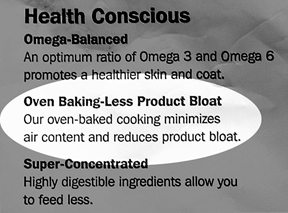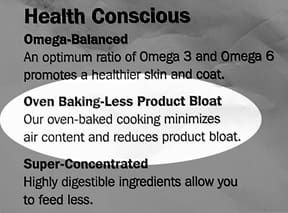The baked versus extruded dog food debate has been slowly smoldering for a number of years. The original, and for a long time only, baked food was Flint River Ranch. However, Petsmart, Old Mother Hubbard, and Natural Balance have recently entered the fray, producing a few baked foods among their extruded foods, and the battle is heating up if youll pardon the expression.
A difference of degrees
Most dry dog foods are extruded. Extrusion is a process that uses heat and very high pressure to create what is essentially an air-popped kibble. The temperature of the food mixture going into the extruder is in the 200-250° F range, but the pressure creates steam and an intense burst of heat. Extruded foods are subject to a quick trip through the extruder at a very high pressure and temperature from as little as 15 or 30 seconds to a minute or two.

The baked food folks, in contrast, extol the virtues of their slow baking process. In fact a number of these foods boast that they are twice-baked. The implication is that this process takes place at a low temperature and therefore the vitamins and other nutrients arent cooked out of the food. What they dont tell you is the baking temperature. I was amazed to find out that these foods are cooked at well over 500° F! Such high temperatures are needed to break down the starches as well as to obtain the hard, crunchy texture of the kibble, but they are not likely to be any less destructive to the nutrients.
Nonetheless, proponents of baked foods claim that baking makes the food more digestible. This is a matter of some debate. The key to digestibility in any dry food is the starchy grain and cereal ingredients. These are not digestible unless they are cooked to a sufficient degree to gelatinize the starches; in other words, to break them down into digestible units. (The digestibility of animal protein, however, is somewhat reduced by cooking.) If you think about it, you wouldnt eat raw rice, barley, couscous, quinoa or polenta. These grains must be cooked before you can obtain any nutritional value from them. Obviously, the starches and grains are cooked in both the baking and the extrusion process.
Search for a competitive edge
Unfortunately for the consumer, it really is difficult to sort out the useful information from the hype, as each company tries to tell you why their product is superior and the other guys are second-rate. But one argument made by a baked food maker struck me as particularly far-fetched. The companys literature claims that extruded foods are more raw, and suggests that this is what necessitates the high amounts of preservatives used in extruded foods. In fact, the need for greater quantities of preservatives in extruded food is actually due to the fact that extruded foods usually have fats, digests, or other flavorings sprayed on after they are extruded and dried. These fats and flavors, which can make the surface of the food oily, are what necessitate the addition of more preservatives than a baked, uncoated food would need.
Baked food makers also like to say that the flavor is baked into rather than sprayed onto their foods, and therefore baked foods are more palatable. Actually, palatability studies generally show that dogs really like those sprayed-on fats and flavors.
Another baked food maker claims that extruded food expands in dogs stomachs when it gets mixed with the digestive juices. In fact, this particular manufacturer went so far as to say that this expansion of extruded kibble can cause bloat! However, there has never been any scientific proof that bloat is less common in baked-food-fed dogs than in extruded-food-fed dogs. True, weve all seen kibbles that have been dropped into the water bowl, and they do swell a little bit when they get wet. How big a factor this is, or whether it creates an actual risk for the dog, is unknown. There is no doubt that baked food is denser because it contains less air, and dogs can usually be fed about 20-25 percent less volume (but about the same weight) of a baked food compared to an extruded one.
The big question
Since most baked food manufacturers also make extruded foods, one must certainly ask the question, if baked is so much better, why are they still making extruded foods? In other words, is it real or is it hype?
The only real difference I can see is this: Because baked foods are generally marketed toward the top end of the market (read: expensive, gourmet foods), they do tend to incorporate better quality ingredients (no by-products) and natural preservatives (rather than the synthetics like BHA, BHT and Ethoxyquin). Extruded foods that utilize ingredients of similar quality are probably not any better or worse than their baked counterparts.
That said, some dogs do seem to do better on a baked food (just as some do better on extruded). If nothing else, trying one of these foods may simply offer another avenue to explore.
-By Jean Hofve, DVM
Dr. Jean Hofve is the Companion Animal Program Coordinator for the Animal Protection Institute, located in Sacramento, California.







But still have questions about the glycate that are formed from extruding…that is my biggest concern… I dont want to cause my dog to get cancer…
What are some examples of Baked Dog Food?
I’d like to see your sources. I’d also like to know if you looked at digestibility studies to determine whether baked or extruded kibble was better? And where did you find out baked kibble was cooked at a higher temperature? What about the drying times and temps between baked and extruded kibble?
A study was published in 2019 showing the digestibility between raw chicken meat, lightly steamed chicken meat, chicken meat meal (found in kibble), and retorted chicken (found in cans). You are completely disregarding the protein in the foods, as well. Chicken meal is roughly 60% digestible, whereas lightly cooked or raw chicken meat is closer to 76% digestible. It just seems like you’re not supplying anything to back up what you’re saying, and ignoring large chunks of available data to sell a viewpoint that you had prior to looking into this at all.
Not to mention the issues with extruded kibble where the fat is sprayed on the outside of the kibble – which oxidizes and degrades the moment it’s exposed to air, meaning a significant loss of EFA’s for dogs eating extruded kibble, whereas baked kibble has the fat, well, baked into it. Kibble in general is meant mainly for convenience and cost effectiveness. If you’re looking for food that is high quality, supplies all the micro and macro nutrients your dog needs in a form it can metabolize, and provides the beneficial microbes and enzymes your dog needs to live healthy, kibble isn’t it. Regardless of how it’s cooked.
I would love to see an update on this article, including a list if current baked dog foods, or at least a filter option on your current recommended dog foods on which ones are baked vs HHE.